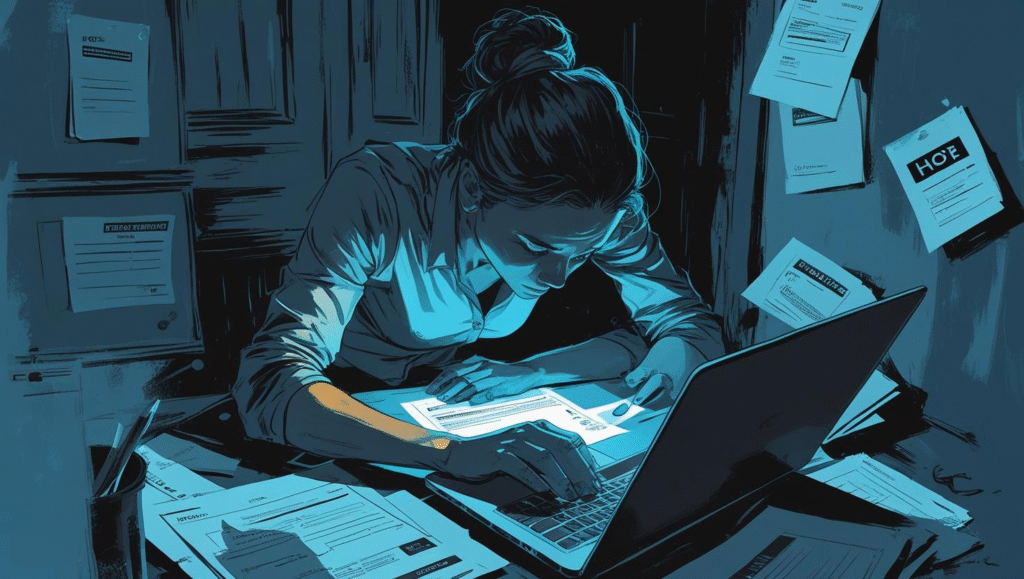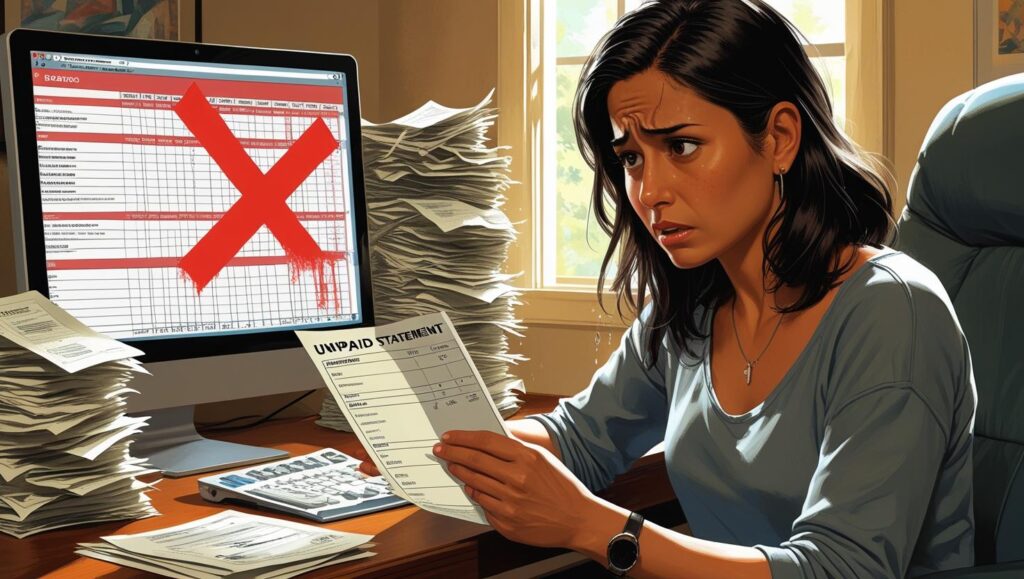The harsh reality!
85% of freelancers worldwide have experienced late payments at least some of the time, with over 21% facing this issue more than half of the time. If you’ve just started freelancing, this statistic might make your stomach drop. But here’s the thing: you don’t have to become part of that statistic.
Welcome to the exciting, and sometimes daunting, world of freelancing! You’ve taken the leap, honed your skills, and landed your first clients. Now comes a critical piece of the puzzle that can make or break your freelance career: getting paid.
For many new freelancers, invoicing feels like navigating a bureaucratic maze, but I’m here to tell you it’s actually one of your most powerful business tools.
Think of your invoice not just as a bill, but as a professional statement of value delivered and a clear directive for payment. Master this, and you’ll build a reputation for professionalism while ensuring a steady income stream. Get it wrong, and you could find yourself spending more time chasing payments than building your business.
The sobering truth? 29% of freelance invoices are paid at least a day late, and the average amount freelancers are currently owed in late payments sits at a staggering £5,230, around USD$7200. But here’s what those statistics don’t tell you: with the right knowledge and systems in place, you can dramatically reduce your chances of joining those numbers.

The Hidden Cost of Poor Invoicing: Why This Matters More Than You Think
Before we dive into the how-to, let’s talk about the why. Late payments aren’t just an inconvenience—they’re a business killer. One in five self-employed workers (20%) have reported that they found themselves with no money to cover basic living expenses such as rent and bills after an experience of late payment. For freelancers, this translates to real hardship: nearly a quarter (23%) have had to use their credit card or overdraft facility and a further one in five freelancers (21%) have used up all or most of their savings as a result of a late payment.
The ripple effects extend beyond your bank account. Almost half of freelancers (49%) state that they have felt stressed or anxious as a result of not getting paid on time, whilst almost one in three (31%) indicated that they felt less productive due to an instance of late payment. When you’re constantly worried about cash flow, it’s impossible to focus on delivering your best work. But here’s the empowering truth: proper invoicing practices can help you avoid these pitfalls entirely.

“If you really look closely, most overnight successes took a long time”.
– Steve Jobs
What to Include: Your Invoice as a Professional Blueprint
A well-crafted invoice isn’t just a random collection of numbers—it’s a professional document that leaves zero room for confusion or delay. After analysing what seasoned freelancers and business experts consistently recommend, here’s what your invoice must include:
Essential Invoice Elements
Your Business Information This might seem obvious, but it’s often the overlooked detail that causes payment delays. Clearly state your full name or business name, complete address, email, and phone number. This information helps your client know exactly who they’re paying and provides a clear point of contact for any queries. Include your professional credentials or business registration number if relevant.
Client’s Information Mirror this detail on the client side. Include your client’s full business name, contact person (if applicable), complete address, and relevant department information. Accuracy here prevents delays caused by misdirected payments or confused accounting departments.
Unique Invoice Number This is vital for tracking and record-keeping, yet many new freelancers forget it. Develop a consistent numbering system (examples: INV-001, INV-2025-001, or [Your Initials]-[Month]-[Sequential Number]). This helps both you and your client easily reference specific transactions and is essential for professional bookkeeping.
Clear Date Information Include both the invoice creation date and, crucially, the due date. The due date should be prominent and unambiguous. This is the foundation of your payment expectations.
Detailed Description of Services/Products Don’t just write “consulting” or “writing services.” Be specific and comprehensive:
- “Content Writing: SEO Blog Post ‘Remote Work Best Practices’ (1,500 words, including keyword research and meta description)”
- “Web Design: Homepage Revamp – Phase 1 (wireframes, design concepts, and initial coding)”
- “Social Media Management: January 2025 (4 weeks of content creation, posting, and community management across Instagram and LinkedIn)”
Include dates of service, project milestones, or delivery dates when relevant. This transparency builds trust and clarifies exactly what the client is paying for.
Quantity/Hours & Rate Structure Whether you charge per hour, per project, or per deliverable, clearly state the quantity and your agreed-upon rate. For hourly work, break it down by task or date. For project work, reference the original proposal or contract.
Financial Breakdown Present a clear mathematical progression:
- Subtotal of services
- Any applicable taxes (VAT, sales tax, etc.)
- Additional expenses (if agreed upon)
- Total Amount Due (make this prominent)
If you need to charge taxes, ensure they’re itemized and correctly calculated according to your local regulations.
Payment Methods & Instructions Remove any friction from the payment process. Provide detailed instructions for each accepted payment method:
- Bank Transfer: Include bank name, account name, account number, sort code (UK) or routing number (US), and any reference information needed
- PayPal: Provide your PayPal email address
- Digital Payments: Include links to payment portals or instructions for card payments
- International Clients: Consider including SWIFT codes for international transfers
Payment Terms This is where many freelancers either save or doom themselves. We’ll explore this in detail next.
Professional Touch End with a simple “Thank you for your business!” or “We appreciate the opportunity to work with you.” This small gesture maintains positive client relationships and demonstrates professionalism.

If you need to charge taxes, ensure they’re itemized and correctly calculated according to your local regulations.
Payment Terms: Your Financial Lifeline
Your payment terms aren’t just administrative details—they’re the rules of engagement that determine your cash flow and financial stability. Here’s what works in the real world:
Standard Payment Terms Explained
Net 30: Payment due 30 days from invoice date This is the most common standard, giving clients a reasonable processing window. However, for new freelancers, especially on smaller projects, this can feel painfully long. With net-30 terms, if you bill 30 hours a week at $100/hour and invoice weekly, you will have about 5 weeks of unpaid work at any given time, which comes out to $15,000. Do you have $15,000 you’d like to lend to clients interest-free?
Net 15: Payment due within 15 days This strikes a better balance for many freelancers, especially for smaller projects or established client relationships. It’s aggressive enough to maintain cash flow while still being reasonable for business payment processing.
Net 7: Payment due within 7 days Ideal for quick turnaround projects, small invoices, or clients with whom you have an established, trusted relationship. This works particularly well for ongoing retainer clients.
Payment in Advance/Deposit For larger projects or new clients, requesting an upfront deposit (typically 25-50% of the total project cost) is not just acceptable—it’s smart business. If a client is reluctant to pay a deposit, this may be a sign that they’ll be reluctant to pay future invoices once work is complete. This practice protects you from potential non-payment and demonstrates the client’s commitment to the project.
Due Upon Receipt This means payment is expected immediately upon invoice delivery. While appealing, it’s often unrealistic for businesses with established payment processing procedures. Use this sparingly, perhaps for very small tasks or emergency work.
Advanced Payment Terms That Get Results
Early Payment Discounts Consider offering terms like “5% 10 Net 30″—offer a 5% discount for payments within 10 days, motivating clients to pay early and boosting your cash flow. This strategy can significantly improve your payment timeline while only costing you a small percentage.
Milestone Payments For larger projects, break payments into milestones: “25% deposit to begin, 50% at project midpoint, 25% upon completion.” This maintains cash flow throughout lengthy projects and reduces your financial risk.
The Critical Pre-AgreementAlways agree on payment terms before starting work. Include them in your contract, proposal, or at minimum, your initial project confirmation email. Most successful freelancers emphasize this pre-agreement as fundamental to good client relations and timely payments. Never assume—always explicitly communicate and confirm your payment expectations.
Formal education will make you a living; self-education will make you a fortune
Jim Rohn



The Art of Strategic Follow-Up: Getting Paid Without Burning Bridges
Even with perfect invoices and clear terms, sometimes payments lag. This is where professionalism and persistent communication become your superpowers. Remember: the goal is to get paid while maintaining positive client relationships for future work.
The Professional Follow-Up Timeline
Proactive Reminder (1-3 days before due date) Prevention is better than cure. Send a friendly heads-up: “Hi [Name], I hope your week is going well. Just a friendly reminder that invoice #[Invoice Number] for [Project Name] will be due on [Due Date]. Please let me know if you have any questions about the payment process.”
This proactive approach often prevents invoices from becoming overdue and demonstrates your professional attention to detail.
First Overdue Reminder (1-3 days after due date) Assume positive intent initially. Many late payments result from oversight, not malice: “Hi [Name], Hope you’re having a good week. I wanted to follow up on invoice #[Invoice Number] for [Project Name], which was due on [Due Date]. I haven’t seen the payment come through yet. Could you please let me know the expected payment date? If there are any questions about the invoice or payment process, I’m happy to help clarify.”
Second Overdue Reminder (7-10 days after due date) This reminder can be slightly firmer while maintaining professionalism. Always reattach the original invoice:
“Hi [Name], This is a follow-up regarding invoice #[Invoice Number] for [Project Name], which is now [X] days overdue. The total amount due is [Amount]. We would appreciate prompt payment of this outstanding invoice. Please confirm when I can expect to receive payment, or let me know if there are any issues that need to be resolved.”
Third Overdue Reminder (14-21 days after due date) At this point, it’s appropriate to mention consequences if they were outlined in your original terms:
“Hi [Name], Invoice #[Invoice Number] for [Project Name] remains unpaid and is now [X] days overdue. As outlined in our original agreement, invoices not paid within [X] days of the due date may incur a late fee of [Amount/Percentage]. Please arrange for immediate payment to avoid additional charges. If there are circumstances preventing payment, please contact me immediately to discuss a resolution.”
Phone Call Strategy If emails aren’t generating responses, a polite phone call often resolves issues quickly. It’s harder to ignore direct conversation. Be prepared with all invoice details and maintain a friendly but professional tone. Frame it as: “I’m calling to follow up on invoice [#] and see if there’s anything I can help resolve to process the payment.”
Payment Plan Consideration If a client is genuinely experiencing financial difficulties, a structured payment plan might be better than no payment at all. Document any new arrangement in writing and consider requiring an initial partial payment to demonstrate good faith.
When Professional Persistence Isn’t Enough
Final Notice For significantly overdue payments (30+ days), consider a formal final notice indicating your intention to pursue other collection methods. Keep it professional but clear about consequences.
Legal Action (Last Resort) For substantial amounts and persistent non-payment, you might need to consider small claims court or debt collection services. This should always be a last resort, as it can damage relationships and be time-consuming. Always weigh the cost versus potential recovery.
Key Insight: 65% of small to medium-sized US businesses (25-200 employees) spend 14 hours per week dealing with late invoices. This means consistent, professional follow-up often resolves payment issues because it moves your invoice to the top of their priority list.
Enjoying our Content?
Share a Comment
on our Facebook Page
Beyond the Basics: Building a Payment Culture That Works
Top freelancers don’t just react to payment issues—they create systems that minimize them. Here’s how to build a robust payment culture around your freelance business:
Foundation Elements
Bulletproof Contracts Before invoicing becomes relevant, ensure every project has a clear, written agreement. This should outline scope, deliverables, deadlines, and payment terms. Many successful freelancers use contract templates from resources like the Freelancers Union or legal template providers. A solid contract is your best insurance against payment disputes.
Immediate Invoicing As soon as work is completed or a billing cycle ends, send that invoice. Don’t delay, don’t wait for the “perfect time.” The sooner an invoice enters their payment system, the sooner it gets processed. You should send an invoice once you’ve provided the goods or services. This practice ensures prompt payment for your goods/services and that the customer knows the amount they owe.
Professional Tools Make a Difference Consider investing in professional invoicing software. Modern tools like Wave, FreshBooks, Invoice Ninja, or Xero can automate reminders, track payment status, and create professional-looking invoices. They also provide crucial audit trails and reporting capabilities. Many offer free plans perfect for new freelancers.
Advanced Relationship Management
Clear Project Communication Keep clients updated throughout projects. Regular progress updates create transparency and ensure no surprises when the invoice arrives. When clients understand the value they’re receiving, they’re more motivated to pay promptly.
Exceptional Service Standards Clients prioritize paying service providers who consistently exceed expectations. Deliver excellent results, communicate clearly, and be genuinely pleasant to work with. There are companies who respect their freelancers and pay them on time. They do the right thing and that often equates to freelancer loyalty and excellent output.
Strategic Payment Method Optimization Offer multiple payment options but be strategic about it. 84% of freelancers report that they would choose instant payments if given the option, and 46% of freelancers are willing to pay a fee to receive payments instantly. Consider offering instant payment options for clients who value speed, even if it involves processing fees.
Technology That Transforms Your Invoicing Game
The right tools can transform invoicing from a time-consuming chore into an automated system that works while you focus on client work. Here’s what to consider:
Free Solutions That Actually Work
Wave Accounting Wave has one of the best free plans when it comes to invoicing features and functionality, boasting unlimited invoices for unlimited clients, recurring billing, automatic payment reminders, and more. The platform also includes accounting features, making it perfect for freelancers who want comprehensive financial management.
Invoice Ninja While Invoice Ninja has Pro and Enterprise plans, their “forever free” plan is more than enough for the majority of freelancers, with a ton of advanced features. It offers professional templates and solid automation features.
PayPal Business A lot of freelancers start with PayPal because it is a familiar platform that many people already have an account with. Not only is PayPal secure, but it also offers a free invoicing function as part of all business accounts.
Professional Upgrades Worth Considering
FreshBooks Widely used among freelancers for its user-friendly interface and comprehensive features. FreshBooks offers several features that streamline invoicing for freelancers, including the option to request a deposit payment on an invoice, time-tracking capabilities, and an option to add expenses to invoices.
Xero Xero is a small business accounting platform that provides advanced features and integration possibilities for freelancers with more complex invoicing needs. It’s particularly valuable if you need robust reporting and accounting integration.
Key Features to Prioritize
When choosing invoicing software, prioritize:
- Automated payment reminders (saves hours of manual follow-up)
- Multiple payment method integration (reduces client friction)
- Professional template customization (builds brand credibility)
- Payment tracking and status updates (provides real-time visibility)
- Mobile accessibility (enables invoicing from anywhere)
- Integration with other business tools (streamlines your entire workflow)

Protecting Yourself: Legal Knowledge Every Freelancer Needs
Understanding your legal rights and protections can make the difference between getting paid and writing off bad debt.
Know Your Rights
Recent legislative developments provide new protections for freelancers. New York’s ‘Freelance Isn’t Free’ Act (FIFA), launched in 2017, was a pioneering law mandating written contracts and timely payments for freelancers. The act has since expanded: New York State expanded these protections statewide on August 28, 2024, reinforcing the commitment to fair treatment for independent workers.
California enacted the Freelance Worker Protection Act (FWPA) on September 28, 2024, taking effect on January 1, 2025. These laws provide important precedents and protections, including requirements for written contracts and penalties for late payment.
Practical Legal Tools
Late Payment Interest In many jurisdictions, you have the legal right to charge interest on overdue invoices. Currently, late payments are governed by the Late Payment of Commercial Debts Act 1998 which allows for interest and debt recovery costs to be claimed if another person or business is late paying for goods or a service.
Copyright Leverage Depending on where you live in the world, if your client or editor hasn’t paid you for your work, then you may still own the copyright. That means that they may not legally be able to use your words until they’ve paid you. This can be powerful leverage in payment disputes.
Professional Resources Only 4% of respondents said they consulted the Small Business Commissioner, Citizens Advice or similar organisations about their issues with late or non-payments. Another 56% of respondents were unaware that they could seek advice from such organisations. Don’t struggle alone—these resources exist to help you.
The Psychological Game: Managing Client Relationships During Payment Issues
Payment disputes can strain even the best client relationships. Here’s how to navigate these challenges while protecting both your finances and your professional reputation:
Maintaining Professionalism Under Pressure
Set Emotional Boundaries I’m not sure you can really call yourself a freelance writer if you’ve never had to chase a late payment. Like taxes and rejection, not being paid on time is (unfortunately) almost a rite of passage for freelancers. Accept that payment issues are part of the business landscape, not personal attacks on your worth or professionalism.
Document Everything Keep records of all communication, agreements, and work delivered. This documentation protects you if disputes escalate and demonstrates your professionalism.
Know When to Walk Away If their first course of action in a crisis is to avoid paying freelancers, that’s not a business relationship I care to keep pursuing. Sometimes, protecting your business means ending relationships with chronically difficult clients.
Building Long-Term Success
Quality Client Relationships Focus on building relationships with clients who value your work and pay promptly. Always make an effort to thank these star clients for their prompt payment. Good clients appreciate recognition and often provide referrals to other quality clients.
Continuous Education Stay informed about best practices, legal developments, and industry standards. Companies that are new to engaging freelancers may not play by the rules because they aren’t even aware of them. Part of your role as a professional is educating clients about proper freelance working relationships.
Your Action Plan: Implementing Professional Invoicing from Day One
Starting your freelancing journey with proper invoicing systems isn’t just about getting paid—it’s about establishing yourself as a serious business professional. Here’s your step-by-step implementation plan:
Week 1: Foundation Setup
- Choose your invoicing software based on your current needs and budget
- Design your invoice template with all essential elements
- Establish your standard payment terms and write them clearly
- Create a contract template that includes your payment terms
- Set up your preferred payment methods and test them
Week 2: Process Development
- Create a client onboarding checklist that includes payment term discussion
- Develop follow-up email templates for each stage of overdue payments
- Set calendar reminders for proactive payment follow-ups
- Research local laws regarding late payment rights and interest charges
- Join professional associations or online communities for ongoing support
Week 3: System Testing
- Send your first professional invoice using your new system
- Monitor payment processing and note any client questions or friction points
- Refine your templates based on real-world use
- Practice your follow-up communications with any delayed payments
- Track your success metrics (average payment time, late payment percentage)
Ongoing: Continuous Improvement
- Monthly: Review your payment statistics and identify trends
- Quarterly: Update your invoicing software and templates as needed
- Annually: Review and adjust your payment terms based on experience
The Bottom Line: Your Freelance Success Depends on Getting Paid
Starting your freelance journey is an incredible achievement that deserves celebration. But that achievement only becomes sustainable success when you master the business fundamentals—and getting paid is the most fundamental of all.
The statistics we’ve explored paint a stark picture: 85% of freelancers face payment delays, and the financial and emotional costs are real. But here’s what those statistics don’t capture: with proper systems, clear communication, and professional persistence, you can join the 15% who consistently get paid on time.
Your invoicing system isn’t just about collecting money—it’s about:
- Establishing credibility with professional, detailed invoices
- Setting boundaries that protect your business and cash flow
- Building relationships with clients who value your professionalism
- Creating predictability in your income stream
- Reducing stress through systematic follow-up processes
Remember: 38% of US small businesses fail exactly due to financial challenges. Don’t let poor invoicing practices threaten the freelance business you’re working so hard to build.
Every time you send a professional invoice with clear terms and follow up systematically on payments, you’re not just requesting money—you’re demonstrating that you’re a serious business professional who values their work and expects others to do the same.
Your skills have value. Your time has worth. Your invoices are how you claim both.
Now go forth, create exceptional work, send professional invoices, and build the thriving freelance business you deserve. Your future self—the one with steady income and reduced financial stress—will thank you for implementing these systems from day one.
Ready to get started? Choose an invoicing platform this week, create your first professional template, and send your next invoice with confidence. You’ve got this!
Your First Steps to Freelance Freedom
